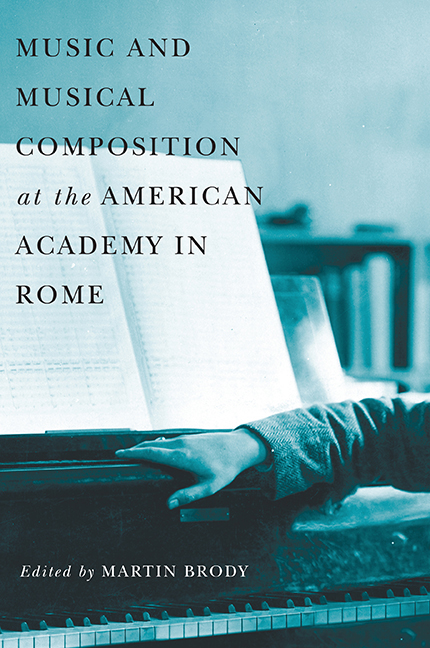Book contents
- Frontmatter
- Contents
- List of Illustrations
- Introduction
- Part One A History of the Rome Prize
- Part Two Origins, Ideology, Patronage
- Part Three Two Case Studies in Internationalism
- Part Four Primary Sources
- 7 What They Said: American Composers on Rome
- 8 The New Music Scene in Rome and the American Presence since World War II: Excerpts from a Roundtable, Moderated by Richard Trythall
- 9 For the Academy
- 10 Two Visits in 1981
- 11 Music Resources at the American Academy in Rome
- Appendix: Composers at the American Academy in Rome, 1921–40
- Selected Bibliography
- List of Contributors
- Index
7 - What They Said: American Composers on Rome
from Part Four - Primary Sources
Published online by Cambridge University Press: 25 October 2017
- Frontmatter
- Contents
- List of Illustrations
- Introduction
- Part One A History of the Rome Prize
- Part Two Origins, Ideology, Patronage
- Part Three Two Case Studies in Internationalism
- Part Four Primary Sources
- 7 What They Said: American Composers on Rome
- 8 The New Music Scene in Rome and the American Presence since World War II: Excerpts from a Roundtable, Moderated by Richard Trythall
- 9 For the Academy
- 10 Two Visits in 1981
- 11 Music Resources at the American Academy in Rome
- Appendix: Composers at the American Academy in Rome, 1921–40
- Selected Bibliography
- List of Contributors
- Index
Summary
Introduction
I arrived at the American Academy in Rome for a stay of several weeks during the summer of 2003. The city was in the midst of an extreme heat wave. Romans were leaving early for the customary August vacations at the seashore or mountains, while those who reluctantly stayed in Rome tended to move and speak as if in slow motion. At the Academy, fans and ice were the most valued possessions, and both were in short supply. Residents gradually replaced professional attire with shorts and T-shirts that became barer and shorter as the heat wave continued. Meals were taken at the long tables in the courtyard, with the desperate hope of catching an occasional breeze.
On my first evening at the Academy, I chose a table and introduced myself. When I asked the person seated next to me about her fi eld of study, she replied simply, “I am a classicist.” Following a second and third similar rejoinder, I was asked to describe my own work, and I said (partly in jest), “I am a modernist.” “Well, what is a modernist?” I fl oundered over a description and then tried, “Americanist,” which drew even more puzzled reactions. I soon realized we were not speaking the same language: classical art and architecture had nothing to do with what musicians think of as “classical” music. Furthermore, for classicists, modernism was thought to have begun somewhere around the time of Bernini. I found myself in an unusual (and humbling) situation—no one knew who I was or about my work. Studies in contemporary arts and recent history were rare, and with few exceptions, American composers were unfamiliar names.
When Aaron Copland had been in residence at the Academy in 1950, he commented in a letter to his young friend Leonard Bernstein that the only American composer known in Italy was George Gershwin. More than half a century later, but for the addition of Copland himself, and perhaps a few pieces by Leonard Bernstein, Charles Ives, and John Cage, the situation had not changed remarkably.
- Type
- Chapter
- Information
- Music and Musical Composition at the American Academy in Rome , pp. 257 - 266Publisher: Boydell & BrewerPrint publication year: 2014



